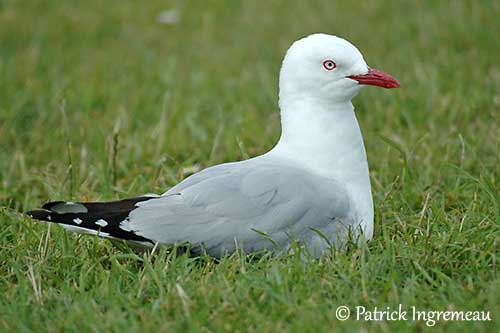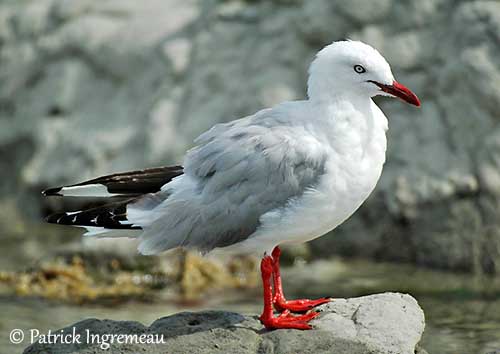
Fr: Mouette scopuline
Ang: Red-billed Gull
Maori: Tarapunga – Akiaki
All: Rotschnabelmöwe
Esp: Gaviota Plateada Neozelandesa - Gaviota de Pico Rojo
Ita: Gabbiano beccorosso
Nd: Roodsnavelmeeuw
Photographers:
Patrick Ingremeau
TAMANDUA
Ian McHenry
My New Zealand Birds
Otto Plantema
Trips around the world
Simon Tan
PBase Bird galleries
Text by Nicole Bouglouan
Sources:
HANDBOOK OF THE BIRDS OF THE WORLD Vol 3 by Josep del Hoyo-Andrew Elliott-Jordi Sargatal - Lynx Edicions - ISBN : 8487334202
KNOW YOUR NEW ZEALAND BIRDS by Lynnette Moon - New Holland Publishers – ISBN: 1869660897
BirdLife International (BirdLife International)
New Zealand bird status between 2008 and 2012
Te Ara – The Encyclopedia of New Zealand
Tiritiri Matangi Open Sanctuary
Red-billed Gull
Chroicocephalus scopulinus
Charadriiformes Order – Laridae Family
INTRODUCTION:
The Red-billed Gull is common along the New Zealand coasts, in both mainland and islands’ regions. It is opportunist and takes advantage of any food source, often frequenting picnic areas, urban parks and refuse dumps.
These gulls are living in large flocks. They feed, roost and breed often in thousands. They are noisy birds, and give repeated shrill calls while competing for food.
Their Maori names are “Tarapunga” and also “Akiaki”.

DESCRIPTION OF THE BIRD:
Biometrics:
Length: 37 cm
Weight: M: 300-320 g – F: 240-260 g
The adult has white plumage, except the pale grey mantle, back and wing-coverts. The outer primaries are black with white tips, and show large, white mirrors. The inner primaries are white with narrow black tips. In flight, this pattern forms a conspicuous white wing patch. The tail is white too.
Bill, eyering, legs and webbed feet are scarlet. The eyes are white to pale yellowish-white.
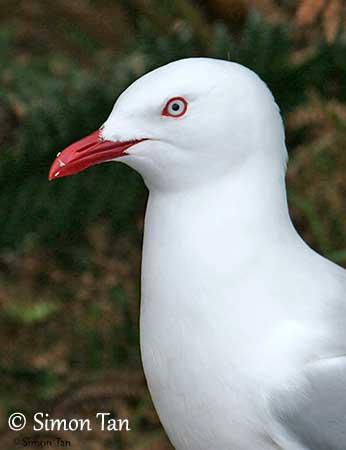
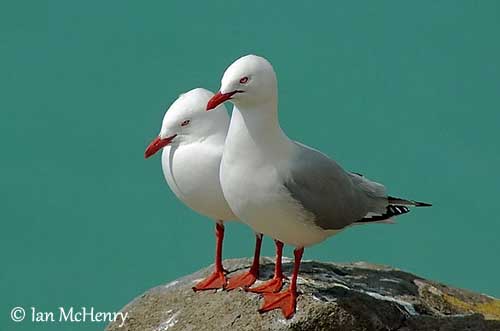
Both sexes have similar plumage, but the female is smaller and the male has stouter bill.
The juvenile resembles adult, but it has brown patches on the mantle, and the primaries are browner rather than black.
Juvenile and immature have dark brown bill, eyes, legs and feet. They obtain the adult plumage in the second year, but they still have dark-tipped bill.
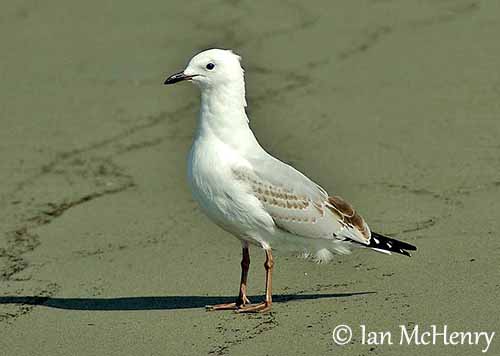
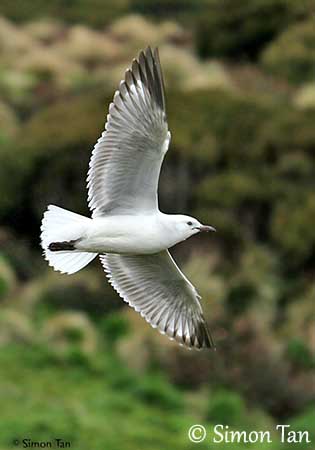
RANGE:
The Red-billed Gull is found in New Zealand, on E coasts of North and South Islands. Inland, they occur at Lake Rotorua in North Island. This species is present on several NZ subantarctic islands such as Stewart I, Chathams, Bounties, Snares, Aucklands and Campbell Island.
HABITAT:
The Red-billed Gull frequents the coastlines of New Zealand, but it can be common in towns too, where it scavenges on human refuse, especially in stormy weather. They gather in flocks in wet fields to feed insects and worms. This species also frequents harbours where it hovers round the shipping.
They breed in colonies established on cliffs, sandy or rocky shores and in estuaries.
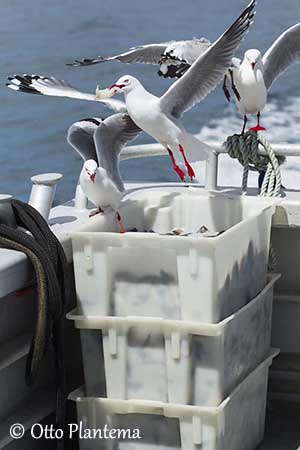
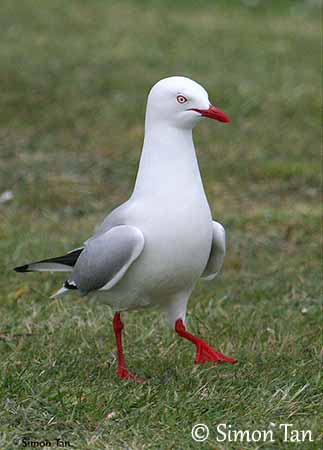
CALLS ANS SONGS: SOUNDS BY XENO-CANTO
The Red-billed Gull has wide range of calls. In the large feeding, roosting or nesting flocks, the birds give high-pitched screeching and also clattering “scrark” and other sounds such as “kwe-aaar”.
If threatened during the breeding season, they utter strident “kek” calls.
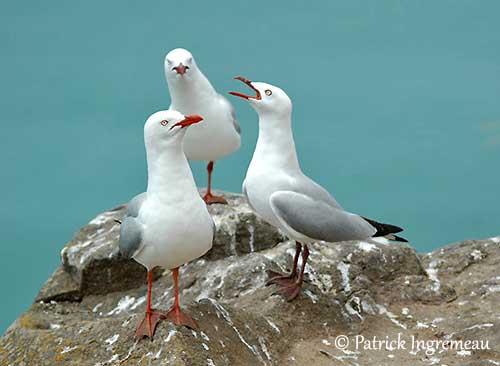
BEHAVIOUR IN THE WILD:
The Red-billed Gull feeds primarily on krill (Nyctiphanes australis), but according to the location of the colony, it also takes earthworms, small fish, crustaceans, molluscs, garbage and kelp flies (Diptera) found on rotten seaweed. Worms and insects are found on wet fields.
It hunts in shallow pools and paddles to disturb marine invertebrates. It also takes offal scraps by following fishing boats where they can form large flocks.
The Red-billed Gull, like numerous other Laridae, often harasses other birds, forcing them to regurgitate their preys.
At the colonies, during the territorial encounters, they often rob the neighbour’s eggs.
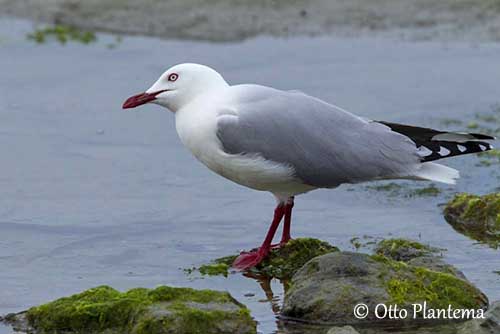
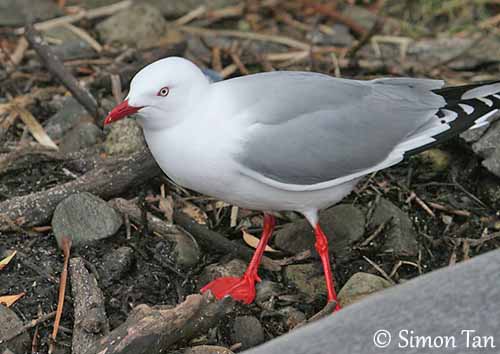
During the breeding season, they form dense colonies on the mainland, whereas they nest in scattered or solitary situations on the islands.
They are monogamous and most pairs last for more than one season. Courtship feeding by male to female is a common behaviour, and increases in frequency two weeks prior the egg laying.
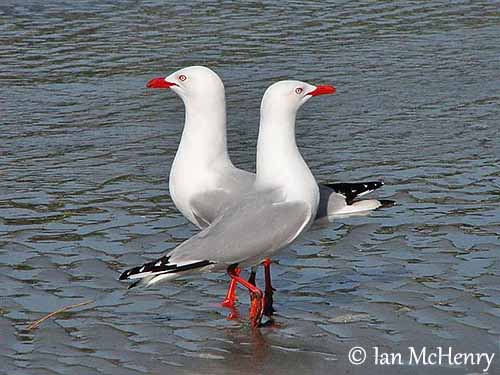
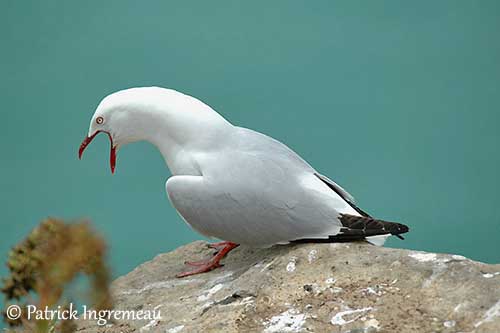
They are very vocal during this period. They perform stereotyped displays such as the common “long call” during which the birds raise the head above the horizontal level and then, gradually lower it while uttering a series of long notes. This call is often followed by series of head’s movements.
Both sexes select the nest-site and build the nest. The courtship displays are more intense and the copulation occurs 8-10 days before the egg laying, always accompanied by calls and “wing-flagging”.
They are territorial and defend the nest-site. The colonies may contain up to 5000 pairs.

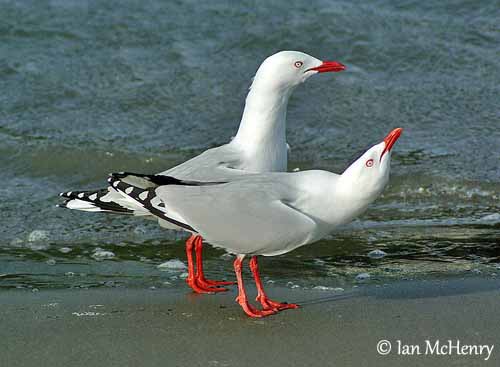
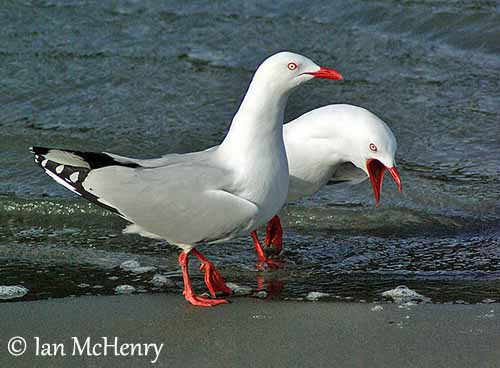
The Red-billed Gull is migratory, but most adults remain within 380/400 kilometres of the colony. However, the juveniles disperse further north.
They are good fliers, very agile and powerful in the air.
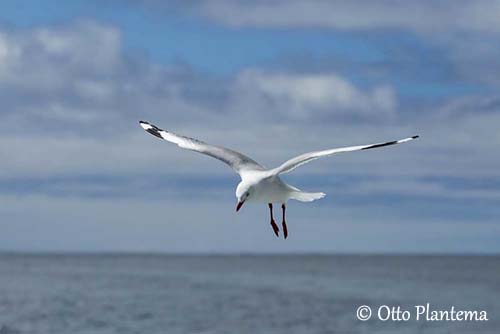
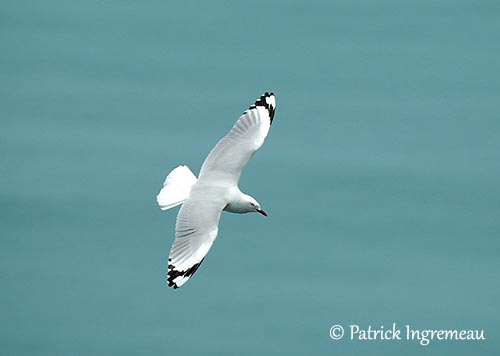
REPRODUCTION OF THIS SPECIES:
The breeding season takes place between September and December-January. They nest in large, dense colonies on sandpits, gravel beaches, rocky stacks and islets.
The nest is a small mound of vegetation with a shallow depression in the centre. It is made with seaweeds, twigs, grasses and feathers.
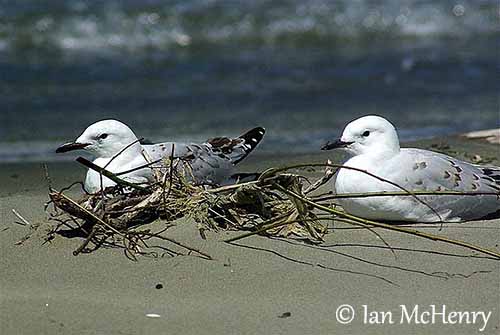
The female lays 2-3 brownish eggs with darker markings. Both adults share the incubation during 24-27 days, and feed the chicks. The young birds can fly at 35 days of age, but they still depend on parents for food for one month.
Adults and chicks often return to the same colony.
Interbreeding has been recorded between the Red-billed Gull and the Black-billed Gull. The hybrids have been fertile and have bred with the Red-billed Gull.
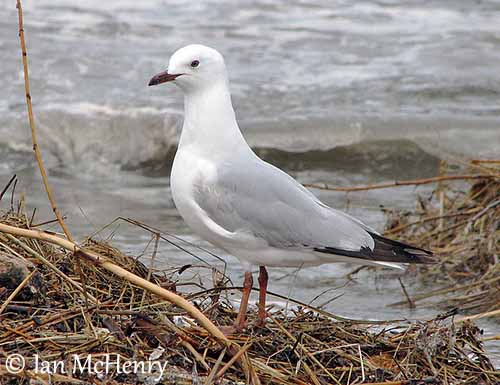
PROTECTION / THREATS / STATUS:
The Red-billed Gull is threatened by mammalian predators such as rats, cats, ferrets and stoats. The food sources can be affected by climate fluctuation.
However, the population is suggested to be increasing due to human activities involving the increase of availability of food during winter.
Currently, the numbers are unknown, but the species is evaluated as Least Concern.
